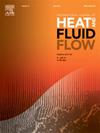A detailed numerical analysis of the flow field characteristics of vortex acoustic streaming around a cylindrical tube
IF 2.6
3区 工程技术
Q2 ENGINEERING, MECHANICAL
International Journal of Heat and Fluid Flow
Pub Date : 2025-05-28
DOI:10.1016/j.ijheatfluidflow.2025.109906
引用次数: 0
Abstract
In this study, a detailed numerical analysis was conducted to investigate the vortex acoustic streaming around a cylindrical tube using the Reynolds stress method. The evolution of acoustic streaming structures across a wide range of parameters was investigated, and the general relationships between acoustic streaming intensity and acoustic parameters were summarized. It was discovered that low-frequency and intense sound waves (20 Hz, 149.33 dB) can generate distorted acoustic streaming with an axisymmetric distribution surrounding the cylindrical tube. This acoustic streaming internally evolves into a flow field characterized by jet-like vortices, with near-wall velocities reaching as high as 710 mm/s. On the contrary, high-frequency (5 kHz) acoustic streaming no longer has the characteristic of axisymmetric distribution. The inhomogeneity of the sound field leads to changes in the vortex scale, with near-wall velocities reaching only 1 mm/s. The acoustic streaming vortex outside the cylindrical tube gradually presents different flow field structure changes as sound pressure level and frequency increase. Moreover, the streaming intensity under different acoustic parameters is analyzed using a dimensionless approach. It is found that a specific function relationship between dimensionless acoustic streaming intensity and Strouhal number exists, and the empirical formula is given.
圆柱管周围涡旋声流场特性的详细数值分析
本文采用雷诺应力法对圆柱管周围的涡旋声流进行了详细的数值分析。研究了大范围参数下声流结构的演化,总结了声流强度与声学参数之间的一般关系。研究发现,低频强声波(20 Hz, 149.33 dB)可在圆柱形管周围产生轴对称分布的畸变声流。这种声流内部演变成以射流涡为特征的流场,近壁速度高达710毫米/秒。相反,高频(5khz)声流不再具有轴对称分布的特征。声场的不均匀性导致了涡旋尺度的变化,近壁速度仅为1 mm/s。随着声压级和频率的增加,圆柱管外声流涡逐渐呈现出不同的流场结构变化。此外,采用无因次方法分析了不同声学参数下的流场强度。发现无因次声流强度与斯特劳哈尔数之间存在特定的函数关系,并给出了经验公式。
本文章由计算机程序翻译,如有差异,请以英文原文为准。
求助全文
约1分钟内获得全文
求助全文
来源期刊

International Journal of Heat and Fluid Flow
工程技术-工程:机械
CiteScore
5.00
自引率
7.70%
发文量
131
审稿时长
33 days
期刊介绍:
The International Journal of Heat and Fluid Flow welcomes high-quality original contributions on experimental, computational, and physical aspects of convective heat transfer and fluid dynamics relevant to engineering or the environment, including multiphase and microscale flows.
Papers reporting the application of these disciplines to design and development, with emphasis on new technological fields, are also welcomed. Some of these new fields include microscale electronic and mechanical systems; medical and biological systems; and thermal and flow control in both the internal and external environment.
 求助内容:
求助内容: 应助结果提醒方式:
应助结果提醒方式:


